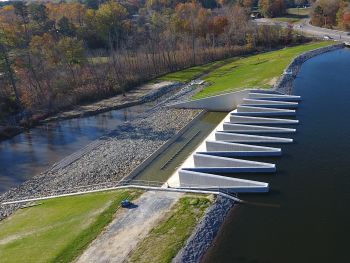Spillway Control Structures

|
| Labyrinth spillways are commonly installed to increase weir length and the associated discharge capacity. |
“The value of an uncontrolled fixed crest spillway in providing an extremely reliable operation and a very low-cost maintenance facility is undeniable. Topographical, geological, economical, and political considerations at many dam sites may restrict the use of an uncontrolled fixed crest spillway. The solution to these problems is usually the inclusion of crest gates; however, the uncontrolled fixed crest spillway should be used regardless of these considerations when the time of concentration of the basin runoff into the reservoir is less than 12 hours. When the time of concentration is between 12 and 24 hours, an uncontrolled fixed crest spillway should be given preference over a gated spillway. Basically, the inclusion of crest gates allows the spillway crest to be placed significantly below the maximum operating reservoir level, in turn, permitting the entire reservoir to be used for normal operating purposes; and results in a much narrower spillway facility, avoiding the problems associated with high unit discharge/high-velocity flow and increased operation and maintenance costs. A gated spillway must include, as a minimum, two or preferably three spillway gates in order to satisfy safety concerns” [1]
Types of Control Structures
- Broad-Crested Weirs
- Sharp-Crested Weirs
- Ogee-Crested Weirs
- Earth-Cut/Vegetated Spillways
- Labyrinth Spillways
- Piano Key Spillways
- Fuseplug Spillways
- Fusegate Spillways
- Gated Spillways
Best Practices Resources
![]() Measurement of Peak Discharge at Dams by Indirect Method (U.S. Geological Survey)
Measurement of Peak Discharge at Dams by Indirect Method (U.S. Geological Survey)
![]() Discharge Characteristics of Broad-Crested Weirs (GSC-397) (U.S. Geological Survey)
Discharge Characteristics of Broad-Crested Weirs (GSC-397) (U.S. Geological Survey)
![]() Hydraulic Design of Spillways (EM 1110-2-1603) (U.S. Army Corps of Engineers)
Hydraulic Design of Spillways (EM 1110-2-1603) (U.S. Army Corps of Engineers)
![]() Design of Small Dams (Bureau of Reclamation)
Design of Small Dams (Bureau of Reclamation)
Citations:
Revision ID: 4453
Revision Date: 11/18/2022
